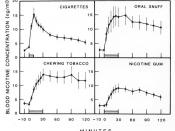The health effects of tobacco smoking are the inhalation of environmental or secondhand tobacco smoke.
World Health Organization reported that an estimate of 26% of male and 9% of females' death is as a result of smoking.
Nicotine is a powerful stimulant and is one of the main factors leading to the continued tobacco smoking. Although the amount of nicotine inhaled with tobacco smoke is quite minimal, as most of it is destroyed by heat, it can still sufficient to cause physical and or psychological dependence.
The amount of nicotine absorbed by the body from smoking depends on the type of tobacco as well as whether the smoke is inhaled and whether a filter is used. Despite the design of various cigarettes advertised and tested on machines to deliver less of the toxic tar, studies have shown that when smoked by humans, instead of machines, they deliver the same amount of smoke.
Ingesting cigarette smoking is one of the most rapid and efficient methods of introducing it into the bloodstream, second to injection. On an average, it takes about ten seconds for the substance to reach the brain. As a result of the combustion process, the development of various nicotine delivery systems, such as the nicotine patch or nicotine gum was created to satisfy smokers crave. This can help the heavily dependent smoker to quit gradually, while discontinuing further damage to health.
Smoking also increases the chance of heart disease. Several ingredients of tobacco lead to the narrowing of blood vessels, increasing the likelihood of blockage, thus a heart attack or stroke. Nicotine also plays a role by its stimulation of adrenaline release, which raises blood pressure, heart rate, and free fatty acids. Cigar and pipe smokers tend to inhale less smoke than cigarette smokers, hence their changes of lung...


